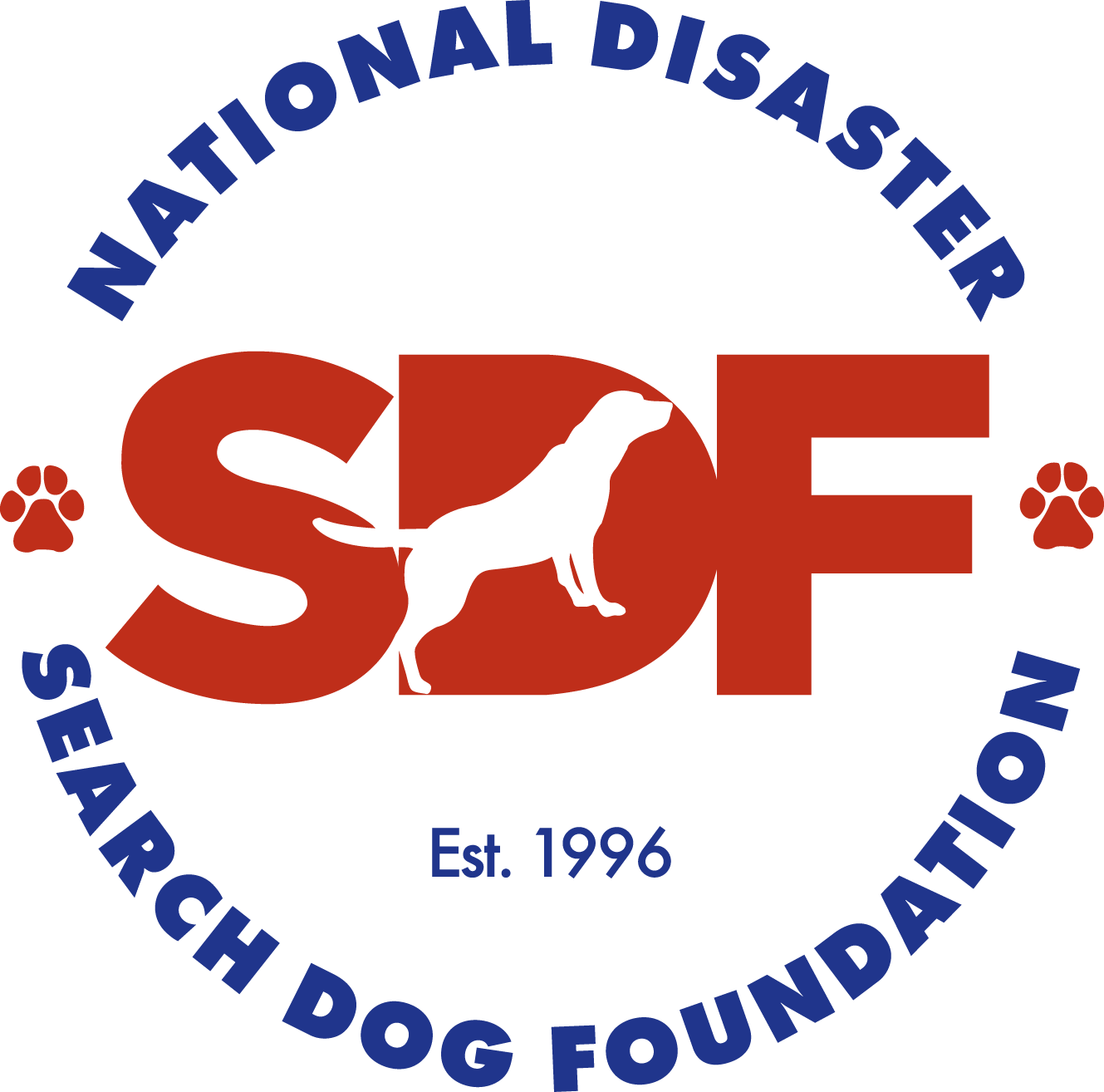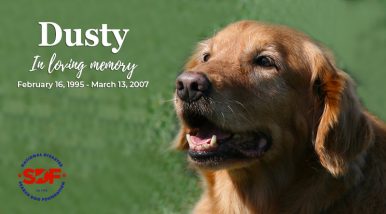As all of you know by now, we in the Metro family, NDSDF, OES, FEMA, and CA-TF7 have suffered a huge loss. On March 12th at about 7:30 in the evening, Dusty, one of our veteran search canines, was struck by a vehicle in front of Station 62. Dusty was on duty with her handler and partner, Captain Randy Gross, at the time. Dusty sustained severe trauma to her lungs and was rushed to the Sacramento Veterinary Surgery Center where she suffered a heart attack secondary to the accident and passed away March 13, 2007 at about 1645 hours.
Ironically, Randy had just announced Dusty’s retirement at a National Disaster Search Dog event in Seaside, Monterey County, on March 10, 2007. After more than 10 years of intense training and dedicated service, Dusty was going to take it easy and become a family dog.
What a lot of you don’t know is the rest of the story.
Dusty and Randy deployed to the World Trade Center with California Task Force 7 on September 11, 2001. It was there that she became one of the most photographed dogs in the nation. Dusty has been honored by the Federal Emergency Management agency (FEMA) and was featured on their website. Her TV credits include an appearance on Animal Planet. She also closed the New York Stock Exchange on September 19, 2001, the only canine to be asked to perform such an honorable task. Not to mention many political leaders have given Dusty a well-deserved pat on the head including President Bush (twice).
Dusty, born in 1995, was one of the very first dogs trained by the National Disaster Search Dog Foundation, established by Wilma Melville, for the Urban Search and Rescue (US&R) Program. In 1997, Dusty, along with Ana and Harley, were the first three dogs recruited for training and use in the US&R arena. All of these dogs were assigned to firefighter handlers from California Task Force 7 in Sacramento. Ana and Captain Rick Lee of Sacramento Fire, as well as Harley and Assistant Chief Rob Cima of El Dorado County Fire, experienced the same level of success as Randy and Dusty. The combination of firefighter handlers and highly trained dogs like Dusty was new to the disaster search world. The Foundation Program and the dedication of all of the canine search teams have contributed to a remarkably successful program that has changed the way we in USAR conduct operations.
<img class=”size-full wp-image-1139 alignleft” src=”https://searchdogfoundation.org/wp-content/uploads/2015/07/rb_dusty3.jpg” alt=”rb_dusty3″ width=”225″ height=”300″ />Dusty and Randy learned their trade from a legendary team in the dog world, Pluis and Kate Davern. Under the watchful direction of Pluis, Dusty honed her skills in new areas that would eventually produce one of the finest search dogs in the Nation, while Randy learned the subtle art of ducking and dodging from the correcting hand of Pluis. Randy learned obedience and how to respond to Dusty’s “directional control” and “bark alert”. When Dusty found a victim she would let Randy know with a strong repeated bark. For those of you that understand canine training, the USAR dogs that come out of the Foundation all have very strong “toy drive”. Like a lot of firefighters I know, Dusty would work her tail off for a little recognition and her toy.
Dusty’s formative years were reported to be entertaining for the Foundation, Sundowners Kennels, and Randy. Golden Rescue in Salinas, CA donated Dusty to the Foundation and they sent her to the Sundowners Kennels. The one-two punch of Sundowners and the Foundation provide a nice mix of boot camp, charm school, and finishing school all rolled into one. Dusty was a little larger than some search dogs—those of us that were friends like to say she was big boned. She had high energy and drive—both great qualities for a rescue dog—but challenging for a handler. Stories abound of being out of control, not responding to commands, and refusing to stay on a leash. But eventually they were able to get Randy trained. Dusty had similar problems, too!
The handlers tell me that one of the secrets to the success of the Foundation is the marriage—the special relationship between the handler and dog. I don’t know if Wilma, Pluis, or match.com arranges the match, but you can’t argue with success. Randy and Dusty were paired up in 1997 and went on to set the standard in this new experimental program, clearing the path for future Fire Fighter teams to follow. I always called her his girlfriend—sorry, Donna. The depth of their relationship cannot be understated.
Two such examples: during a fairly recent training I watched as Dusty and Randy worked a pile. The seemingly effortless manner in which handler and canine searched and communicated was truly inspiring. The familiarity between the two could only come from years of constant work, training and understanding. During the search, Dusty would react to the subtle changes in Randy’s body language that years of experience had taught how to respond without any verbal direction. Randy would watch and know what the slightest lift of her head, twitch of her tail, or position of her body meant. It was these slight, intuitive signs between dog and handler that controlled the search. When Dusty found a victim and was waiting for her reward—remember the toy—her whole body would shake, her tail would wag, her jaw would quiver—sounds like Randy at a CE. At her age—no I won’t tell—she could still give the young pups a run for their money. I don’t know who was happier—Randy or Dusty.
<img class=”alignright size-full wp-image-1138″ src=”https://searchdogfoundation.org/wp-content/uploads/2015/07/rb_dusty2.jpg” alt=”rb_dusty2″ width=”200″ height=”300″ />Another such example was in the early stages of 9/11: the Blue Rescue Team of TF7 was working the night shift and searching in the lowest levels of the WTC complex some six stories below ground. We were searching the subway terminal and as Dusty approached one of the train cars she stepped off of the platform and onto what appeared to be a solid surface of a slightly darker color. The area she stepped into was actually the subway track some 5-6 feet deep filled with sludge—a mixture of water runoff from the ongoing firefight and all of the oil, gasoline, and other products that a six-story underground parking garage produce. She had a difficult time getting out of the water-filled track area due to the darkness and all of the colors blending together in the glow of cyalume sticks and flashlights. When she finally made her way out of the goo my first thought was “When did Randy get a black lab?” or “My, black really does make you look thinner!” Dusty was covered in sludge and all you could see of her, given the dark eerie lighting, were her tongue and her eyes. Dusty did not seem the least bit concerned, she was pulling on her leash, and wanted to continue the search. She knew the job wasn’t done. She had unbelievable drive, that one. The team was now six stories below grade and the decon area was at ground level several blocks away. Our adventure into the subway took several hours and Randy and I were concerned that whatever she was contaminated with could cause some serious issues.
We made our way out to TF7 forward Base of Operations (BoO) in about an hour. The most direct route out took us through some areas that were still smoldering, very hot, and covered with soot. Dusty was trying to rub against anything and everyone she could in order to get the stuff off of her. The FEMA system provides a VMAT (Veterinary Medical Assistance Team) on such incidents and they were waiting for Dusty when she got there. They tried several different brands of soap—liquid, solid, and other dog shampoos, but nothing would cut the oil. Nothing worked at the VMAT BoO so one of Metro’s very own, Ray Winsor, recommended that Dusty try some of the citrus-based liquid hand degreaser in the cache at our BoO. Dusty received a military escort several blocks back to our BoO at Church and Dey Streets. Dusty soon had a glowing grey coat and the drive to search. Being the dedicated team that Randy and Dusty were, they finished their shift at about 0800 hours that morning. Later that same morning a rep from the VMAT team recommended Randy to try some “Dawn” liquid detergent. While this isn’t a product endorsement, it worked. They use Dawn to decon animals contaminated in crude oil spills. The girl had a way of making a big splash.
The life of a canine search team is incredibly sexy (read with sarcasm here). The first two to three years are filled with at least 20-30 hours of training every week, hundreds of miles of travel in order to find “the right pile”, and thousands of dollars of expenses in food, vet care, canine accoutrements, and the like—and all of this before you have even been certified. (Remember, us firefighters are all about the reward—that period when preparation meets opportunity at a disaster). After you’re certified, there are 5-10 hours of training every week with all of the same travel and care expenses.
A big tip of the hat to Randy, Dusty, and Wilma Melville, the founder of the National Disaster Search Dog Foundation, as well as Debra Tosch, the current executive Director, and every canine search team out there. Dusty as the first, you have set the bar high—THANKS!
Dusty’s drive to search, and commitment and trust in Randy, led to a unique team. She would search anything, anywhere, anytime without hesitation under extreme conditions.
As a Search Team Manager, as a friend, I will miss her.
Captain Dave Stoddard


